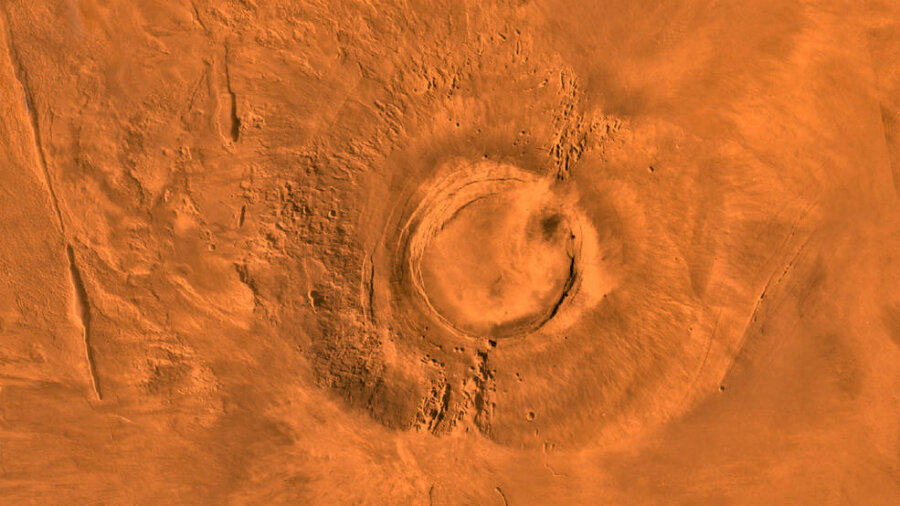Is there a link between dinosaurs' extinction and this Martian volcano?
Loading...
Martian volcanologists now have something else to brag about, besides a cool-sounding job title: They think they’ve nailed down the timeline of Mars’s Arsia Mons volcano.
The southernmost of a volcanic trio making up the colossal Tharsis Montes feature, Arsia Mons’s giant caldera could swallow up all the water in Lake Huron and still have room for more. Fortunately for the Curiosity rover, the mountain is extinct today, but that wasn’t always the case. Eruptions probably peaked while the Stegosaurus roamed the earth, and likely bit the dust along with the Triceratops, according to NASA scientists.
“We estimate that the peak activity for the volcanic field at the summit of Arsia Mons probably occurred approximately 150 million years ago – the late Jurassic period on Earth – and then died out around the same time as Earth’s dinosaurs,” said Jacob Richardson, a postdoctoral researcher at NASA’s Goddard Space Flight Center, in a press release.
Dr. Richardson, of course, refers to the non-avian dinosaurs such as Tyrannosaurus, as the avian branch of the dinosaur family is alive and well today.
But any apparent correlation is purely a temporal coincidence, as even the most astronomically-inclined dinosaur would have been hard-pressed to detect a sign of the eruptions from Earth. By Terran standards, Arsia Mons's activity was quiet and rare.
At its peak, the Arsia Mons’s caldera probably oozed up to two cubic miles of magma every million years, gradually building up the volcano layer by layer.
“Think of it like a slow, leaky faucet of magma,” said Richardson. “Arsia Mons was creating about one volcanic vent every 1 to 3 million years at the peak, compared to one every 10,000 years or so in similar regions on Earth.”
Today, the Mars Reconnaissance Orbiter can spy with its mighty eye 29 volcanic vents in the caldera, and the team started by using that data to map the boundaries of the lava flows, and determine who was on top of whom.
The usual geologic dating tricks don’t work without direct access to the rocks in question, so the researchers had to get creative to figure out how old each flow was, just from looking at the orbiter’s pictures.
By counting the number of craters over a certain size, the volcanologists were able to figure out the ages of the flows. Older ones have had longer to get bombarded with space rocks while younger ones feature relatively few pockmarks.
Richardson and his colleagues at the University of South Florida then developed a computer simulation to parse through all the data and reconstruct a timeline for the volcano’s life, which they suggest can provide insight into the geology and history of Mars.
“A major goal of the Mars volcanology community is to understand the anatomy and life cycle of the planet’s volcanoes. Mars’ volcanoes show evidence for activity over a larger time span than those on Earth, but their histories of magma production might be quite different,” Jacob Bleacher, a planetary geologist at Goddard and a co-author on the study, said in the press release. “This study gives us another clue about how activity at Arsia Mons tailed off and the huge volcano became quiet.”
When compared with Earth, many have a tendency to think of Mars as a dead world (although it keeps surprising us in that department), but the results of this study serve as a reminder that the active histories of both planets overlap significantly.
As Richardson points out, “It’s possible, though, that the last volcanic vent or two might have been active in the past 50 million years, which is very recent in geological terms.”








